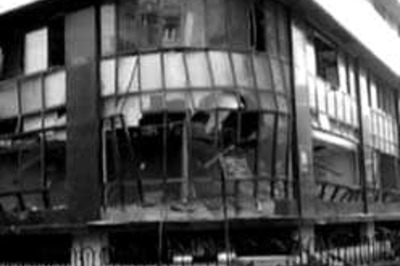
views
India’s first Vande Metro was launched this week and the Ministry of Railways has plans to extend the service to several cities across the country soon. Vande Metro, official called ‘Namo Bharat Rapid Rail’, is the newest form of rapid rail.
The first Vande Metro is operational between Bhuj and Ahmedabad which are around 350 km apart. So far, the fastest train between the two stations used to take at least six hours. This new train is covering the distance in less than six hours and costs about Rs 455 per passenger. This train has 12 coaches with a seating capacity for 1,150.
GREENHOUSE EMISSION, COMFORTABLE COMMUTE
For cities that are 100 km, 200 km or 300 km apart, there are limited options for travel. People either have to drive or take public buses. In trains, there are three categories of services – express or mail that do not stop at every small station; ordinary trains; and electric multiple unit (EMU) which mainly runs in the suburban sections of major cities or mainline electric multiple unit (MEMU) which runs on mainline.
Encouraging the masses to use public transport will help the country achieve its bigger aim of reducing greenhouse gas emission. But people are also looking for smarter, faster and more comfortable modes of commute.
Offering one such service, the Regional Rapid Transit System (RRTS) was partially launched last year between Delhi and Meerut. Once fully functional, the new service will ease the journey for those travelling between Delhi, Ghaziabad and Meerut. But even these services have limitations.
A lively and eager crowd brimming with excitement gathered to catch a glimpse of the Bhuj-Ahmedabad #NamoBharatRapidRail as it reaches its destination in Ahmedabad, Gujarat.#RailInfra4Gujarat#RapidRail#VandeBharatExpress pic.twitter.com/bcZDNP9Jl5— Ministry of Railways (@RailMinIndia) September 16, 2024
LIMITATIONS OF METRO, RRTS
RRTS and Metro projects are the same when it comes to building new infrastructure that costs a huge sum of money and the time taken for building these on new routes.
For Delhi metro, the cost of building one kilometre length is somewhere between Rs 200 crore and Rs 600 crore, depending upon the section (elevated/underground). For RRTS, this amount is around Rs 400 crore per kilometre.
Also, these projects take a lot of time to build. The idea of RRTS was pitched in 2005 and it took almost two decades for it to become reality.
HOW VANDE METRO OFFERS SOLUTION
Indian Railways has a massive Broad Gauge (BG) network of about 62,000 km. It also has stations across the country. So the basic infrastructure for running a faster, dedicated, modern and more comfortable train service is ready. The only investment needed is a new train set.
“For building metros across the city or for the rapid transit system, heavy investment is needed. Also, land is also required. But Vande Metros can run on existing tracks and use existing stations,” a Railway Ministry official explained.
There is a huge rush of people during peak hours to bigger cities from smaller towns around it. Be it Delhi, Mumbai, Kolkata or Chennai or any other metro city. People come from far away every day for work or for education. For those not opting for roads, EMU/MEMU are the best options.
Vande Metro, the official explained, will be offering better comfort and faster travel than EMU/MEMU.
Citing examples, the official said that trains coming to Mumbai from Pune, Lonavala, Palghar; or to Delhi from Meerut, Baghpat, Faridabad and Gurugram; or to Kolkata from Haldia; or to Chennai from Puducherry and Tirupati have huge rush around peak hours.
“Those going to colleges or for work between these cities are struggling as they have to depend on existing express trains. Many people don’t prefer non-AC travel. So a dedicated train during peak hours will ease the journey for a lot of commuters. Also, it will take away the load from unreserved coaches,” they explained.
It will be a reliable service, just like Delhi Metro and RRTS. The passengers will know its timing, seat vacancy and status of running through the already existing system.
Namo Bharat Rapid Rail: for short-distance travel between cities…#ComingSoon pic.twitter.com/MazJ36CMX5— Ashwini Vaishnaw (@AshwiniVaishnaw) September 16, 2024
STATE-OF-THE-ART TRAIN SETS
Vande Metro trains offer fully air-conditioned journeys and can operate at a speed of 110 km/h. It is equipped with KAVACH and offers safety from collision. They are equipped with fire detection, and aerosol-based fire suppression, along with emergency lights.
The semi-permanent couplers, similar to those on Vande Bharat trains, offer a jerk-free travel experience.
Passengers will benefit from modern amenities, including mobile-charging sockets with both type-C and type-A outlets, CCTV surveillance for added security, and route-map indicators above the doors. These trains are also designed keeping in mind disabled people.
Continuous LED lighting ensures a well-lit environment, and a talk-back system allows passengers to communicate with the driver in emergencies.
Vande Metro has double-leaf automatic sliding doors, similar to those in urban metro trains, and a fully sealed flexible gangway that ensures a dust-free, quiet, and rain-proof interior.
The Vande Metro has the potential to transform intercity travel in India, giving the nation its much-needed reform.


















Comments
0 comment